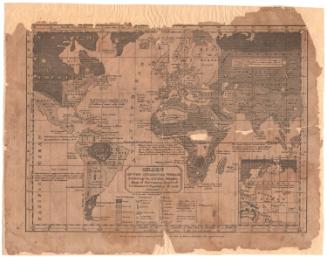A Chart of the World
PublisherPublished by
Hutchinson & Dwier
(American, 1834 - 1836)
Date1834
MediumEngraving; black printer's ink and watercolor on paper, lined with linen
DimensionsPrimary Dimensions (image height x width): 17 1/2 x 21 3/16in. (44.5 x 53.8cm)
Platemark (width only): 23 1/2in. (59.7cm)
Sheet (height x width): 22 1/8 x 25 7/8in. (56.2 x 65.7cm)
Mount (height x width): 22 1/8 x 25 7/8in. (56.2 x 65.7cm)
Other (Rollers): 22 3/8 x 31 1/2in. (56.8 x 80cm)
ClassificationsGraphics
Credit LineThe Newman S. Hungerford Museum Fund
Object number2011.507.0
DescriptionMap of the world, depicting all of the continents except Antarctica. Countries are depicted, labeled and divided by broken solid lines, with cities denoted by circles. Color is used to show the spread of the following religions: Protestant, Roman Catholic, Greek Church, "Mahometanism," and "Paganism." Missionary stations are denoted with crosses. A table below the map, titled "Extent and Population," provides the size in square miles and population of Europe, Asia, Africa, North and South Americas, and Polynesia.
Five vignettes appear below the map depicting scenes meant to represent the Protestant, Muslim, pagan, Roman Catholic and Jewish religions. Below this is a table, titled, "A Chart Exhibiting the Progress of Christianity from the birth of our Saviour to the Present time," that shows the incidence of Christianity versus paganism in the countries of Europe, Asia, Africa, South America and North America, from AD 100 to 1800.
Five vignettes appear below the map depicting scenes meant to represent the Protestant, Muslim, pagan, Roman Catholic and Jewish religions. Below this is a table, titled, "A Chart Exhibiting the Progress of Christianity from the birth of our Saviour to the Present time," that shows the incidence of Christianity versus paganism in the countries of Europe, Asia, Africa, South America and North America, from AD 100 to 1800.
Label TextHartford, Connecticut was a major center for the production of maps and atlases for use in schools. This chart combines both geographical and historical information into a single handy chart, incorporating such diverse topics as the comparative heights of mountains, forms of government, prevailing religions, and the races of man inhabiting each country. The chart is clearly prejudiced in favor of white Anglo-Saxon Protestants who formed by far the greatest part of Connecticut's population in the 1830s. Other religions and races are very negatively portrayed. A huge influx of immigrants during the following decades would produce a much more diverse population, leading both to a greater awareness of differences between peoples, but also to potential conflicts.
NotesCartographic Note: No scaleStatus
Not on view









